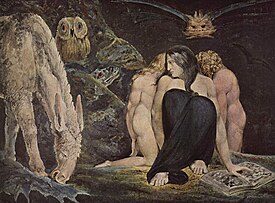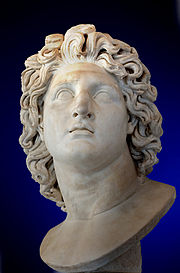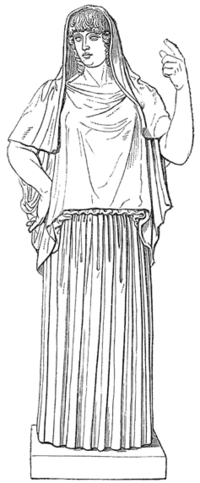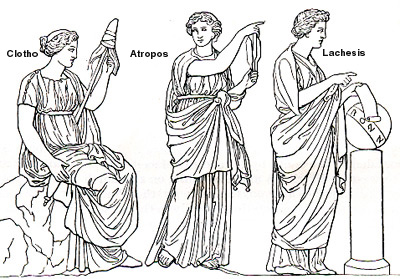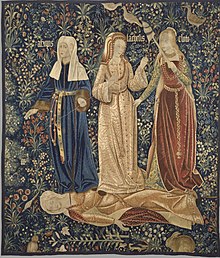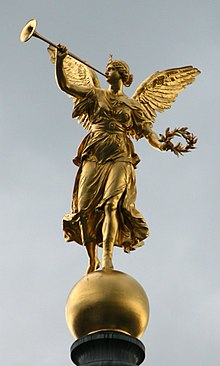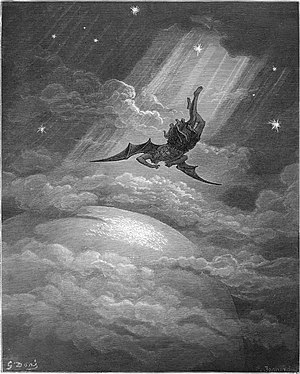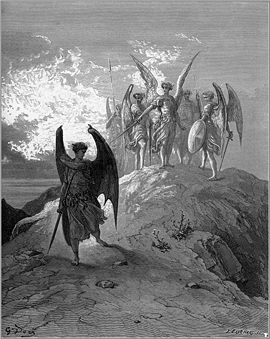Hebe
Hebe

In Greek mythology, Hēbē (Greek: Ἥβη) is the goddess of youth (Roman equivalent: Juventas). She is the daughter of Zeus and Hera.http://en.wikipedia.org/wiki/Hebe_%28mythology%29#cite_note-2 Hebe was the cupbearer for the gods and goddesses of Mount Olympus, serving their nectar and ambrosia, until she was married to Heracles, (Roman equivalent: Hercules); her successor was the young Trojan prince Ganymede. Another title of hers, for this reason, is "Ganymeda." She also drew baths for Ares and helped Hera enter her chariot.http://en.wikipedia.org/wiki/Hebe_%28mythology%29#cite_note-3
In Euripides' play Heracleidae, Hebe granted Iolaus' wish to become young again in order to fight Eurystheus. Hebe had two children with her husband Heracles: Alexiares and Anicetus.http://en.wikipedia.org/wiki/Hebe_%28mythology%29#cite_note-4 In Roman mythology, Juventas received a coin offering from boys when they put on the adult men's toga for the first time.
The name Hebe comes from Greek word meaning "youth" or "prime of life". Juventasjuvenile. In art, Hebe is usually depicted wearing a sleeveless dress. There is a bronze statue of Hebe, by Robert Thomas; (1966), in Birmingham city centre, England . Antonio Canova also sculpted four different statues of Hebe: one of them is in the Museum of Forlì, in Italy. likewise means "youth", as can be seen in such derivatives as
The figure of Hebe was popular in the 19th century and early 20th century for garden fountains and temperance fountains, and was widely available in cast stone. Tarentum, Pennsylvania displays two such cast stone statues of Hebe The mold for these statues was donated to the borough by the Tarentum Book Club on June 6, 1912. In Vicksburg, Mississippi, the Bloom Fountain installed in 1927 near the municipal rose garden, thanks to a bequest of $6,500 in the will of Louis Bloom, features a Hebe of cast zinc. At Bowling Green, Kentucky, the Hebe fountain in Fountain Square follows Canova's model, in patinated cast iron, purchased in 1881 from the J. L. Mott Iron Works of New York, at a cost of $1500. similar Hebe fountains, probably also from Mott, are located in Court Square, Memphis, Tennessee and in Montgomery, Alabama, and one with bronze patination was formerly the Starkweather Fountain in Ypsilanti, Michigan, installed in 1889.http://en.wikipedia.org/wiki/Hebe_%28mythology%29#cite_note-7
She was portrayed as a young woman, wearing a sleeveless dress. On various vases she is shown as cup bearer of the gods, or as bride of Heracles. Famous was the --now lost -- statue of Hebe, made of ivory and gold, by Naucydes (brother of Polycletus) in the 5th century BCE. This statue was also shown on more recent coins from Argos.
http://en.wikipedia.org/wiki/Hebe_%28mythology%29#cite_note-7
Hebe

In Greek mythology, Hēbē (Greek: Ἥβη) is the goddess of youth (Roman equivalent: Juventas). She is the daughter of Zeus and Hera.http://en.wikipedia.org/wiki/Hebe_%28mythology%29#cite_note-2 Hebe was the cupbearer for the gods and goddesses of Mount Olympus, serving their nectar and ambrosia, until she was married to Heracles, (Roman equivalent: Hercules); her successor was the young Trojan prince Ganymede. Another title of hers, for this reason, is "Ganymeda." She also drew baths for Ares and helped Hera enter her chariot.http://en.wikipedia.org/wiki/Hebe_%28mythology%29#cite_note-3
In Euripides' play Heracleidae, Hebe granted Iolaus' wish to become young again in order to fight Eurystheus. Hebe had two children with her husband Heracles: Alexiares and Anicetus.http://en.wikipedia.org/wiki/Hebe_%28mythology%29#cite_note-4 In Roman mythology, Juventas received a coin offering from boys when they put on the adult men's toga for the first time.
The name Hebe comes from Greek word meaning "youth" or "prime of life". Juventasjuvenile. In art, Hebe is usually depicted wearing a sleeveless dress. There is a bronze statue of Hebe, by Robert Thomas; (1966), in Birmingham city centre, England . Antonio Canova also sculpted four different statues of Hebe: one of them is in the Museum of Forlì, in Italy. likewise means "youth", as can be seen in such derivatives as
The figure of Hebe was popular in the 19th century and early 20th century for garden fountains and temperance fountains, and was widely available in cast stone. Tarentum, Pennsylvania displays two such cast stone statues of Hebe The mold for these statues was donated to the borough by the Tarentum Book Club on June 6, 1912. In Vicksburg, Mississippi, the Bloom Fountain installed in 1927 near the municipal rose garden, thanks to a bequest of $6,500 in the will of Louis Bloom, features a Hebe of cast zinc. At Bowling Green, Kentucky, the Hebe fountain in Fountain Square follows Canova's model, in patinated cast iron, purchased in 1881 from the J. L. Mott Iron Works of New York, at a cost of $1500. similar Hebe fountains, probably also from Mott, are located in Court Square, Memphis, Tennessee and in Montgomery, Alabama, and one with bronze patination was formerly the Starkweather Fountain in Ypsilanti, Michigan, installed in 1889.http://en.wikipedia.org/wiki/Hebe_%28mythology%29#cite_note-7
She was portrayed as a young woman, wearing a sleeveless dress. On various vases she is shown as cup bearer of the gods, or as bride of Heracles. Famous was the --now lost -- statue of Hebe, made of ivory and gold, by Naucydes (brother of Polycletus) in the 5th century BCE. This statue was also shown on more recent coins from Argos.
http://en.wikipedia.org/wiki/Hebe_%28mythology%29#cite_note-7


